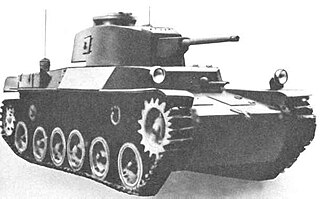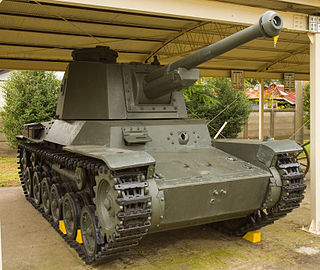Related Research Articles

The Type 94 tankette was a tankette used by the Imperial Japanese Army in the Second Sino-Japanese War, at Nomonhan against the Soviet Union, and in World War II. Although tankettes were often used as ammunition tractors, and general infantry support, they were designed for reconnaissance, and not for direct combat. The lightweight Type 94 proved effective in China as the Chinese National Revolutionary Army had only three tank battalions to oppose them, and those tank battalions were equipped only with some British export models and Italian CV-33 tankettes. As with nearly all tankettes built in the 1920s and 1930s, they had thin armor that could be penetrated by .50 caliber (12.7 mm) machine gun fire at 600 yards (550 m) range.

The Type 97 Light armored car Te-Ke was a tankette used by the Imperial Japanese Army in the Second Sino-Japanese War, at Nomonhan against the Soviet Union, and in World War II. It was designed as a fast reconnaissance vehicle, and was a replacement for the earlier Type 94 tankette.

The Type 97 Chi-Ha was a medium tank used by the Imperial Japanese Army during the Second Sino-Japanese War, the Battles of Khalkhin Gol against the Soviet Union, and the Second World War. It was the most widely produced Japanese medium tank of World War II.

The Type 95 Ha-Gō was a light tank used by the Empire of Japan during the Second Sino-Japanese War, at Nomonhan against the Soviet Union, and in the Second World War. It proved sufficient against infantry but was not effective against other tanks. Approximately 2,300 were produced, making it the most numerous Japanese armoured fighting vehicle of the Second World War.

The Type 1 medium tank Chi-He was an improved version of the Type 97 Chi-Ha medium tanks of the Imperial Japanese Army in World War II. It had a more powerful main gun, engine and thicker armor. It was the first Japanese tank to have a communication radio as standard equipment. Production of the tank did not begin until 1943, due to the higher priority of steel allocated to the Imperial Navy for warship construction. A total of 170 units were built. All of the tanks produced were allocated for the defense of the Japanese home islands, against the anticipated Allied Invasion.

Type 3 Medium Tank Chi-Nu was a medium tank of the Imperial Japanese Army in World War II. Like the Type 1 Chi-He, this tank was an improved version of the Type 97 Chi-Ha. It incorporated a Type 3 75 mm tank gun, one of the largest Japanese tank guns during the war.

The Imperial Japanese Army (IJA) initially purchased foreign tanks for evaluation during World War I, and began developing its own indigenous designs during the late 1920s.

The Type 95 heavy tank was the final result of Japanese multi-turreted tank design and was in commission during the time period between World War I and World War II. The main armament being a 70 mm cannon in a central turret, with its secondary front turret mounting a 37 mm gun and a 6.5 mm machine gun in the rear turret. Four prototypes were produced in 1934.
The Type 97 57 mm tank gun was originally the main armament of the Imperial Japanese Army Type 97 Chi-Ha medium tank during the Second World War.
The Type 4 Ke-Nu was a light tank of the Imperial Japanese Army in World War II. It was a conversion of existing Type 95 Ha-Go light tanks, re-fitted with the larger turret of the Type 97 Chi-Ha medium tank.

The Type 89 medium tank I-Go is a medium tank used by the Imperial Japanese Army from 1932 to 1942 in combat operations of the Second Sino-Japanese War, at Khalkhin Gol against the Soviet Union, and in the Second World War. The Type 89B model was the world's first mass-produced diesel engine tank. The tank was armed with a short-barrel 57 mm cannon for knocking out pillboxes and masonry fortifications, and proved effective in campaigns in Manchuria and China, as the Chinese National Revolutionary Army had only three tank battalions to oppose them, which consisted primarily of Vickers export models, German Panzer Is, and Italian CV33 tankettes. The Type 89 was a 1920s design medium tank, built to support the infantry, and thus lacked the armor or armament of 1940s generation Allied armor; it was regarded as obsolete by the time of the 1939 battles of Khalkhin Gol, against the Soviet Union. The code designation "I-Go" comes from the katakana letter [イ] for "first" and the kanji [号] for "number". The designation is also transliterated Chi-Ro and sometimes "Yi-Go".

O-I was the name given to a proposed series of Japanese super-heavy tanks, to be used in the Pacific Theater. The vehicle was planned to be very heavy and have a crew of 11. The complete history of the O-I is unknown, due to the “obscure” nature of the project and the limited documentation known to have survived post-war.

The Type 97 Shinhōtō Chi-Ha was a Japanese medium tank used in World War II that was an upgrade to the original Type 97 Chi-Ha. The new version was designated Type 97-Kai ("improved"), Shinhōtō Chi-Ha or simply "Type 97/47". Armed with a Type 1 47 mm tank gun, this design was considered to be the best Japanese tank to have seen combat service during the Pacific War. It first saw combat service at Corregidor Island in the Philippines in 1942.

This article deals with the history and development of tanks of the Japanese Army from their first use after World War I, into the interwar period, during World War II, the Cold War and modern era.
The Reconnaissance regiment in the Japanese language was a type of military establishment within the Imperial Japanese Army during the 1940-1945 period. Derived from the Cavalry regiment, the Reconnaissance regiment was tasked with combat scouting. In Japanese military literature, the term reconnaissance regiment is commonly abbreviated as SO. These regiments were often attached to numerous Japanese divisions during the initial stages of the Pacific War. In contemporary Japan, these regiments are analogous to Reconnaissance battalions within the divisions of the Japan Ground Self-Defense Force.
The 3rd Tank Regiment was an armored regiment of the Imperial Japanese Army in World War II. It served in the China/Manchuria theater throughout the war.
References
- ↑ Coox, Alvin (1985). Nomonhan: Japan Against Russia, 1939. Stanford University Press. pp. 349–350. ISBN 978-0804711609 . Retrieved August 3, 2016.
- ↑ Taki. "The History of Battles of Imperial Japanese Tanks – Part I". Taki's Home Page. Retrieved August 3, 2016.